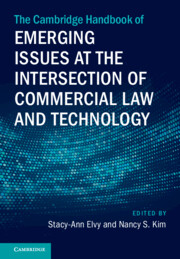Book contents
- The Cambridge Handbook of Emerging Issues at the Intersection of Commercial Law and Technology
- The Cambridge Handbook of Emerging Issues at the Intersection of Commercial Law and Technology
- Copyright page
- Epigraph
- Contents
- Figures
- Tables
- Contributors
- Preface
- Acknowledgments
- Part I Contemporary Technological Developments
- 1 Non-fungible Tokens in Commercial Transactions
- 2 The Challenges of Technological Property
- 3 Regulation under the EU Artificial Intelligence Act
- 4 Blockchain and the Uniform Commercial Code
- 5 Can Technology Foster Price Transparency in Credit Card Processing Markets?
- 6 Quantum Privacy
- 7 Give It Back
- Part II The Implications of Emerging Product Design and Business Models
- Part III Contracting and Dispute Resolution
- Index
7 - Give It Back
Title in Digital Property
from Part I - Contemporary Technological Developments
Published online by Cambridge University Press: 08 February 2025
- The Cambridge Handbook of Emerging Issues at the Intersection of Commercial Law and Technology
- The Cambridge Handbook of Emerging Issues at the Intersection of Commercial Law and Technology
- Copyright page
- Epigraph
- Contents
- Figures
- Tables
- Contributors
- Preface
- Acknowledgments
- Part I Contemporary Technological Developments
- 1 Non-fungible Tokens in Commercial Transactions
- 2 The Challenges of Technological Property
- 3 Regulation under the EU Artificial Intelligence Act
- 4 Blockchain and the Uniform Commercial Code
- 5 Can Technology Foster Price Transparency in Credit Card Processing Markets?
- 6 Quantum Privacy
- 7 Give It Back
- Part II The Implications of Emerging Product Design and Business Models
- Part III Contracting and Dispute Resolution
- Index
Summary
The recent crypto winter – and the malfeasance of crypto bad actors – has revealed a difficulty in the developing law of digital property. Although the standard recourse for improperly taking someone else’s rivalrous digital property should be conversion (pay for it) or replevin (give it back), courts have only begun the common law process of articulating standards for these causes of action. In short, the current law invites and incentivizes digital theft because it can be very hard to get digital property back. We argue here that the common law is strongest in technology cases when it proceeds by analogy well-rooted in traditional case law, and that digital conversion and replevin are directly applicable to situations where someone has converted or improperly taken the digital property of another.
- Type
- Chapter
- Information
- The Cambridge Handbook of Emerging Issues at the Intersection of Commercial Law and Technology , pp. 148 - 168Publisher: Cambridge University PressPrint publication year: 2025

